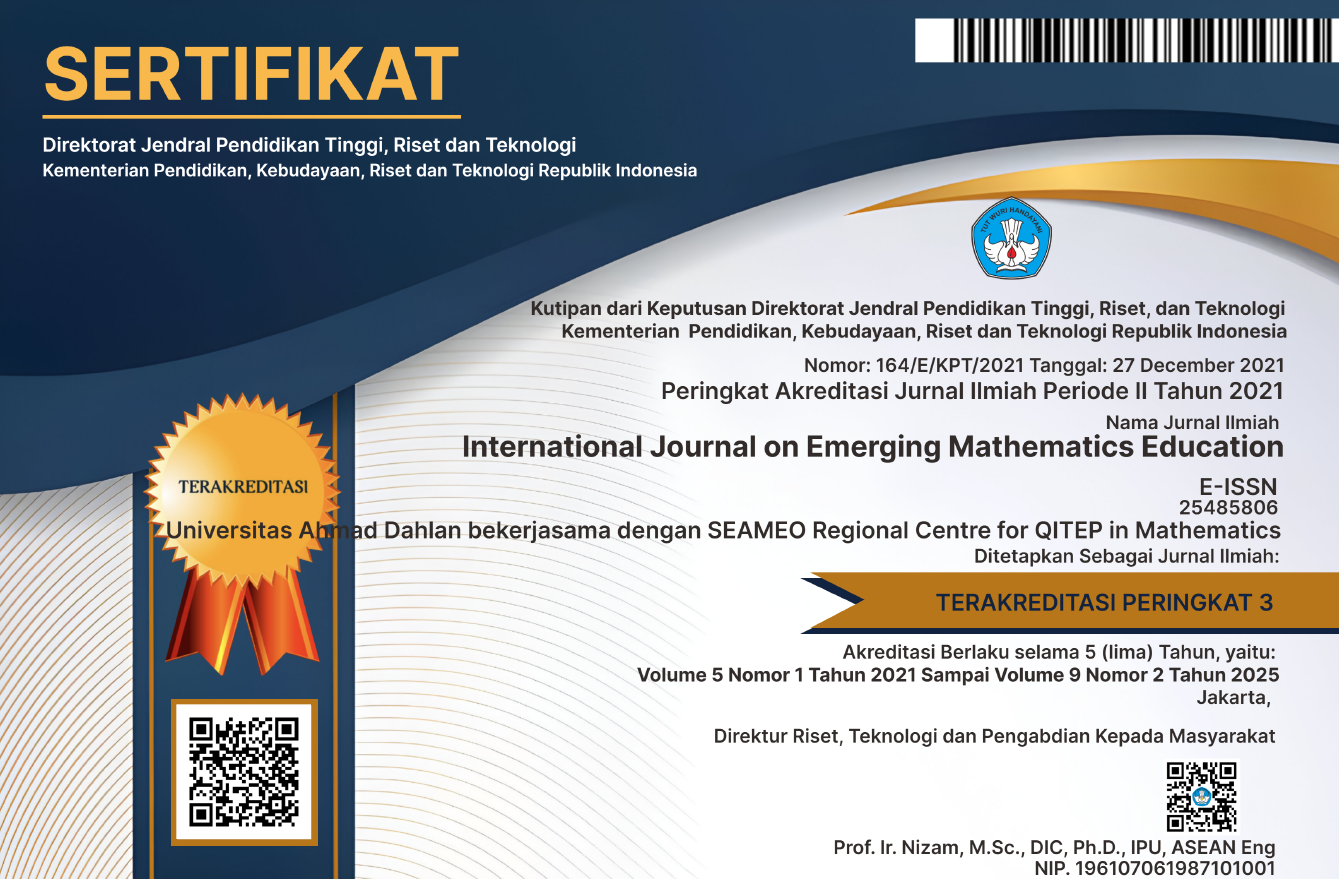Exploring Derivatives by Means of GeoGebra
DOI:
https://doi.org/10.12928/ijeme.v2i1.8670Keywords:
Geogebra, derivatives, calculus, design researchAbstract
The paper aims to explain how GeoGebra can be used in a differential calculus course to explore the Derivative concepts by providing dynamic-visualizations of the concept. Design research methodology was used in this research by designing an instructional design (hypothetical learning trajectories) in the first phase and conducting the teaching experiment in the second phase. The data collected during the experiment consist of video recordings of the classroom activities, observations, interviews, and students written work. In the third phase of the design research, the data were analyzed retrospectively by comparing the actual learning process and the hypothetical learning trajectory. The results show that the dynamic feature of GeoGebra offers the possibility of zooming in on a graph corresponds to taking infinitesimal when a secant line transforms into a tangent line. This builds a foundation for the understanding of the definition of derivative intuitively.References
Ahuja, O.P., Lim-Teo, Suat-Khoh and Lee, Peng Yee. (1998). Mathematics Teachers’ Perspective of Their Students’ Learning in Traditional Calculus and Its Teaching Strategies. Journal of the Korea Society of Mathematical Education Series D: Research in Mathematical Education, 2(2), 89-108.
Amiel, T., Reeves, T. C. (2008). Design-Based Research and Educational Technology: Rethinking Technology and the Research Agenda. Educational Technology and Society, 11(4), 29-40.
Cobb, P., Stephan, M., McClain, K., and Gravemeijer, K. (2001). Participating in Classroom Mathematical Practice. The Journal of the Learning Science, 10(1 & 2), 113-163.
Cobb, P., Confrey, J., diSessa, A., and Lehrer, R. (2003). Design Experiments in Educational Research. Educational Researcher, 32(1), 9-13.
Diković, L. (2009). Applications GeoGebra into Teaching Some Topics of Mathematics at the College Level. ComSIS, 6(2), 191-203.
Edelson. D. C. (2002). Design Research: What We Learn When We Engage in Design. The Journal of The Learning Sciences, 11(1), 105-121.
Gravemeijer, K., and Cobb, P. (2006). Design Research from a Learning Design Perspective, Educational Design Research. London and New York: Routledge,
Gravemeijer, K., and Doorman, M. (1999). Context Problems in Realistic Mathematics Education: a Calculus Course as an Example. Educational Studies in Mathematics, 39(1-3), 111-129.
Haciomeroglu, E. S., and Andreasen, J.B. (2013). Exploring Calculus with Dynamic Mathematics Software. Mathematics and Computer Education, 47(1), 6-18.
Haciomeroglu, E. S., Aspinwall, L., Presmeg, N.C. and Knott, L. (2009). Visual and Analytic Thinking in Calculus. The Mathematics Teacher, 103(2), 140-145.
Haciomeroglu, E. S., Aspinwall, L. and Presmeg, N. (2010). Contrasting Cases of Calculus Students' Understanding of Derivative Graphs. Mathematical Thinking and Learning, 12(2), 152-176.
Hohenwarter, M., Hohenwarter, J., Kreis, Y., and Lavicza, Z. (2008). Teaching and Learning Calculus with Free Dynamic Mathematics Software GeoGebra, TSG 16: Research and development in the teaching and learning of calculus, ICME 11, Monterrey, Mexico.
Kleiner, I. (2001). History of the infinitely small and the infinitely large in calculus. Educational Studies in Mathematics, 48(2–3), 137–174.
Lee, P. Y. (2006). Teaching Secondary School Mathematics. Singapore: Mc Graw Hill.
Özmantar, M. F., Akkoc, H., Bingolbali, E., Demir, S., and Ergene, B. (2010). Pre-Service Mathematics Teachers’ Use of Multiple Representations in Technology-Rich Environments. Eurasia Journal of Mathematics, Science & Technology Education, 6(1), 19-36.
Rasmussen, C., Marrongelle, K., and Borba, M.C. (2014). Research on calculus: what do we know and where do we need to go. ZDM, 46(4), 507-515.
Simon, M. A. (1995). Reconstructing Mathematics Pedagogy from a Constructivist Perspective. Journal for Research in Mathematics Education, 26(2), 114-145.
Struik, D. J. (Ed.). (1969). A source book in mathematics, 1200–1800. Cambridge: Harvard University Press.
Tall, D.O. (2009). Dynamic mathematics and the blending of knowledge structures in calculus. ZDM, 41(4), 481-492.
Varberg, D., Purcell, E., and Rigdon, S. (2006). Calculus 9th Edition. New York: Pearson.
Weigand, G. H. (2014). A Discrete Approach to the Concept of Derivative. ZDM, 46(4), 603-619.
Zimmerman, W. (1991). Visual Thinking in Calculus. In W. Zimmermann and S. Cunningham (Editors), Visualization in Teaching and Learning Mathematics (pp. 127-138). Washington, DC: Mathematical Association of America.
Downloads
Published
How to Cite
Issue
Section
License
License and Copyright Agreement
In submitting the manuscript to the journal, the authors certify that:
- They are authorized by their co-authors to enter into these arrangements.
- The work described has not been formally published before, except in the form of an abstract or as part of a published lecture, review, thesis, or overlay journal. Please also carefully read the International Journal on Emerging Mathematics Education (IJEME) Author Guidelines at http://journal.uad.ac.id/index.php/IJEME/about/submissions#authorGuidelines
- That it is not under consideration for publication elsewhere,
- That its publication has been approved by all the author(s) and by the responsible authorities, tacitly or explicitly, of the institutes where the work has been carried out.
- They secure the right to reproduce any material that has already been published or copyrighted elsewhere.
- They agree to the following license and copyright agreement.
Copyright
Authors who publish with the International Journal on Emerging Mathematics Education (IJEME) agree to the following terms:
- Authors retain copyright and grant the journal the right of first publication with the work simultaneously licensed under a Creative Commons Attribution License (CC BY-SA 4.0) that allows others to share the work with an acknowledgment of the work's authorship and initial publication in this journal.
- Authors are able to enter into separate, additional contractual arrangements for the non-exclusive distribution of the journal's published version of the work (e.g., post it to an institutional repository or publish it in a book), with an acknowledgment of its initial publication in this journal.
- Authors are permitted and encouraged to post their work online (e.g., in institutional repositories or on their website) prior to and during the submission process, as it can lead to productive exchanges, as well as earlier and greater citation of published work.
![]()
Ciptaan disebarluaskan di bawah Lisensi Creative Commons Atribusi-BerbagiSerupa 4.0 Internasional.




